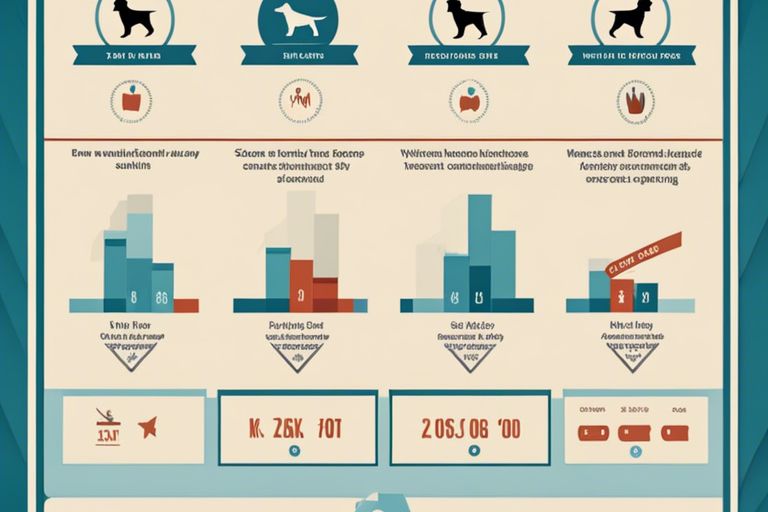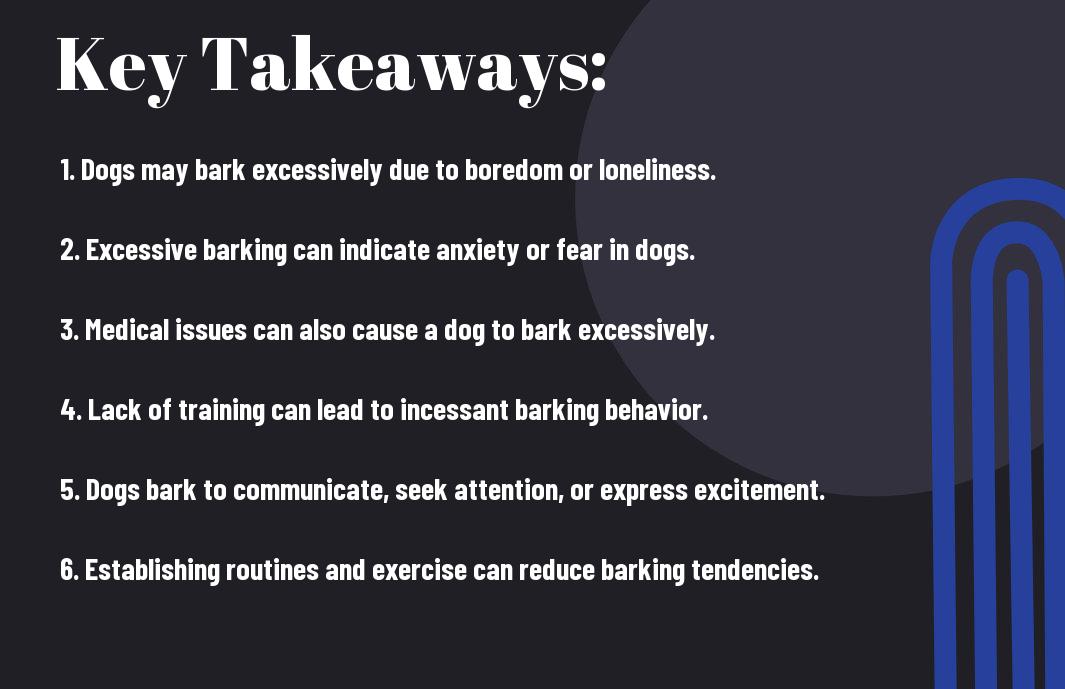It’s a common situation for dog owners to be puzzled by their furry friend’s relentless barking. Understanding the underlying reasons behind excessive barking is crucial in deciphering your canine companion’s communication. In this blog post, we will probe into the various meanings and potential causes behind why a dog barks excessively, shedding light on this common behavior in our beloved pets.
Key Takeaways:
- Communication: Dogs bark as a form of communication, expressing various emotions and needs such as fear, boredom, separation anxiety, or alertness.
- Attention Seeking: Excessive barking could indicate that a dog is seeking attention, whether it’s due to lack of exercise, mental stimulation, or loneliness.
- Training and Socialization: Proper training and socialization are key to addressing excessive barking in dogs, helping them to understand boundaries and respond appropriately to different situations.
The Basics of Dog Barking
Before delving into the reasons why dogs bark excessively, it’s necessary to understand the fundamentals of dog barking. If you’re wondering why your furry friend is barking so much, you may find valuable insights in this blog post about Why Does My Dog Bark So Much (& What To Do About It!).
Why Dogs Bark
One of the primary ways dogs communicate is through barking. They bark to express various emotions, such as excitement, fear, boredom, or alertness. Understanding the underlying reasons for your dog’s barking can help address the issue effectively.
Types of Barks
Barks come in different forms, each indicating a specific message. Some common types of barks include playful barks, territorial barks, attention-seeking barks, or separation anxiety barks. It’s crucial to pay attention to the context and frequency of your dog’s barking to decipher its meaning accurately.
| Playful Barks | Expressing joy and excitement during playtime or social interactions. |
| Territorial Barks | Guarding their territory or alerting to potential threats in their environment. |
| Attention-Seeking Barks | Seeking interaction, play, or treats from their human companions. |
| Separation Anxiety Barks | Manifesting distress when left alone, often accompanied by destructive behaviors. |
| Aggressive Barks | Signaling discomfort, fear, or aggression, requiring careful observation and handling. |
Thoroughly understanding the context and nuances of your dog’s barks can provide valuable insights into their emotional state, enabling you to respond appropriately.
Emotional Reasons for Excessive Barking
Anxiety and Fear
Barking excessively can be a sign that your furry friend is feeling anxious or fearful. Dogs may bark repeatedly when they are in situations that make them uncomfortable, such as being left alone for long periods, encountering unfamiliar people or animals, or hearing loud noises like thunderstorms or fireworks. In these instances, barking is their way of expressing distress and seeking reassurance.
Excitement and Playfulness
To understand why your dog barks so much out of excitement or playfulness, consider their perspective. When a dog is thrilled or eager to play, they may bark to communicate their joy and enthusiasm. This behavior is often seen when they are anticipating a walk, game, or interaction with their favorite human. It’s their way of showing their eagerness and engaging in the moment.
The key is to distinguish between barking out of excitement and excessive barking due to anxiety or fear. Pay attention to your dog’s body language and the context of their barking to determine the underlying emotions.
Attention Seeking
The incessant barking may also be your dog’s way of seeking attention from you. Dogs are social animals that thrive on interaction with their human companions. If they feel neglected or bored, they may resort to barking as a way to get noticed and engage with you. This behavior is reinforced when barking results in attention, whether positive or negative, as any response from you validates their actions.
The key to addressing attention-seeking barking is to provide ample mental and physical stimulation for your dog to prevent boredom. By ensuring that they receive enough exercise, playtime, and attention, you can help curb this behavior and strengthen your bond with your canine companion.
Environmental Triggers for Excessive Barking
Noise and Distractions
All dogs have different tolerance levels for noise and distractions. Some breeds are more sensitive to loud sounds and sudden movements, which can trigger excessive barking. When a dog is constantly exposed to loud noises or excessive distractions, it can lead to heightened levels of anxiety and stress, causing them to bark excessively.
Changes in Environment
Environmental changes in a dog’s living space can be a significant trigger for excessive barking. Dogs are creatures of habit and sudden changes such as moving to a new home, rearranging furniture, or even introducing new household objects can disrupt their sense of security. This disruption can cause anxiety in dogs, leading to increased barking as a way to communicate their discomfort or unease.
Presence of People or Animals
The presence of unfamiliar people or animals can trigger excessive barking in dogs. When a dog senses a new person or another animal in their territory, they may perceive it as a threat and bark to alert their owners or establish dominance. Additionally, dogs that are not socialized properly may resort to barking as a defensive mechanism in response to perceived threats.
Medical Reasons for Excessive Barking
Once again, excessive barking in dogs can sometimes be attributed to underlying medical issues. It’s important to consider these factors when trying to understand why your furry friend may be vocalizing more than usual.
Pain and Discomfort
To start, pain and discomfort can be significant contributors to a dog’s increased barking behavior. Dogs may bark excessively if they are in physical pain due to conditions such as arthritis, injuries, or dental problems. It’s crucial to monitor your dog for any signs of discomfort, such as limping, decreased appetite, or changes in behavior, and seek veterinary attention if necessary.
Sensory Issues
Pain, discomfort, and sensory issues can also play a role in causing a dog to bark excessively. Sensory issues, such as hearing loss or vision impairment, can lead to increased barking as a way for the dog to express confusion or anxiety. It’s important to be aware of any changes in your dog’s sensory abilities and to provide extra support and reassurance to help them feel more comfortable in their environment.
This subsection highlights the importance of addressing sensory issues in dogs, as these can significantly impact their behavior and well-being. By understanding and accommodating these sensory challenges, pet owners can help their dogs feel more secure and reduce excessive barking.
Medical Conditions
Issues like thyroid problems, neurological disorders, or cognitive dysfunction can manifest as increased barking in dogs. These medical conditions can affect a dog’s ability to regulate their behavior and communication, leading to excessive vocalization. If you notice a sudden change in your dog’s barking patterns, it’s crucial to consult with a veterinarian to rule out any underlying medical issues.
Another aspect to consider is that certain medications or treatments for medical conditions can also lead to increased barking as a side effect. It’s important to discuss any changes in your dog’s behavior with a veterinarian to determine the best course of action for managing their overall health and well-being.
Breed-Specific Barking Tendencies
Small Breeds
One factor to consider when understanding why a dog barks a lot is its breed. Small breeds, such as Chihuahuas and Yorkshire Terriers, are known to be more vocal compared to larger breeds. These pint-sized pups have a tendency to bark at anything they find unusual or threatening, which can be triggered by unfamiliar noises, people, or animals.
Large Breeds
On the other hand, large breeds like German Shepherds and Golden Retrievers may bark less frequently than their smaller counterparts. However, when they do bark, it can be much louder and more imposing. Large breeds often bark as a form of alerting their owners to potential dangers or to communicate their needs.
The size of a dog can play a role in its barking habits. Larger breeds may have deeper, more resonant barks that carry further distances, making them seem louder even if they bark less frequently than smaller breeds.
Working Breeds
The working breeds, such as Border Collies and Australian Shepherds, are known for their intelligence and high energy levels. As a result, these breeds may bark more often as a way to release pent-up energy or to express their need for mental stimulation. Working breeds were originally bred to perform tasks such as herding livestock, so barking was a way for them to communicate with their human handlers during their work.
To address excessive barking in working breeds, providing ample exercise, training, and interactive toys can help stimulate their minds and prevent boredom-induced barking episodes.
Training and Behavioral Solutions
Not all hope is lost when it comes to managing a dog that barks excessively. There are various training and behavioral solutions that can help address this behavior and improve the overall well-being of your furry friend.
Positive Reinforcement
Any time your dog exhibits quiet behavior, such as not barking when the doorbell rings or staying calm during a walk, make sure to reward them with treats, praise, or affection. Positive reinforcement can help reinforce the desired behavior and teach your dog that being quiet is a positive and rewarding experience.
Redirecting Attention
To redirect your dog’s attention away from barking, try using toys, games, or puzzles to keep them mentally stimulated and engaged. You can also teach your dog commands like “quiet” or “focus” to help shift their focus away from barking and onto a different, more positive behavior.
Redirecting attention is an effective way to break the barking cycle and encourage your dog to engage in other activities that are more appropriate and less noisy.
Desensitization Techniques
On top of positive reinforcement and redirecting attention, desensitization techniques can also help reduce excessive barking in dogs. These techniques involve gradually exposing your dog to the triggers that cause them to bark, such as other dogs or loud noises, in a controlled and positive way.
For instance, if your dog barks at other dogs while on a walk, you can start by exposing them to dogs from a distance where they don’t bark and reward them for staying calm. Over time, you can decrease the distance between your dog and other dogs, continuing to reward calm behavior until they can be near other dogs without barking excessively.
Conclusion
From above, it is clear that when a dog barks a lot, it could be due to various reasons such as boredom, anxiety, fear, or seeking attention. Understanding the underlying cause of excessive barking is crucial in addressing the issue and helping the dog lead a more balanced and peaceful life. By observing the dog’s behavior, seeking professional help if needed, and providing proper training and enrichment, pet owners can work towards reducing excessive barking and promoting their dog’s well-being.
FAQ
Q: Why does my dog bark excessively?
A: Excessive barking in dogs can be caused by various reasons such as boredom, separation anxiety, seeking attention, fear, territorial behavior, or as a response to other dogs.
Q: How can I determine the cause of my dog’s excessive barking?
A: Observing the situations in which your dog barks excessively can help you identify the trigger. Keep a log of these instances to pinpoint the underlying cause.
Q: What can I do to reduce my dog’s excessive barking?
A: To help minimize your dog’s barking, provide regular exercise, interactive toys, training to address behavior issues, mental stimulation, and create a calm environment.
Q: Is excessive barking a sign of a deeper issue in my dog?
A: While occasional barking is normal, excessive and persistent barking can indicate underlying problems such as anxiety, fear, pain, or physical discomfort that may require a visit to the vet.
Q: Can professional training help curb my dog’s excessive barking?
A: Yes, hiring a professional dog trainer or behaviorist can provide you with the tools and techniques to address your dog’s excessive barking habit through positive reinforcement and behavior modification strategies.




